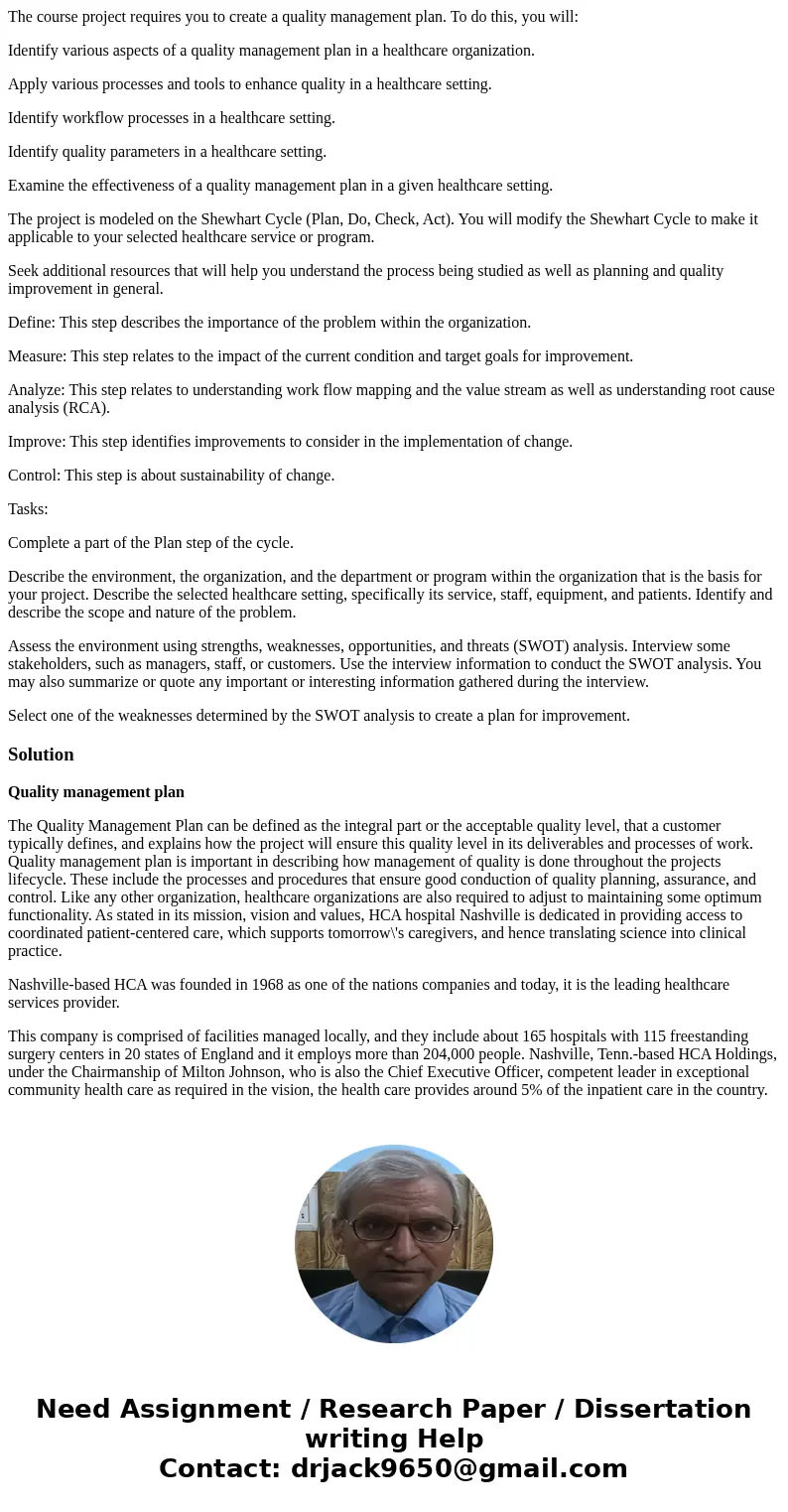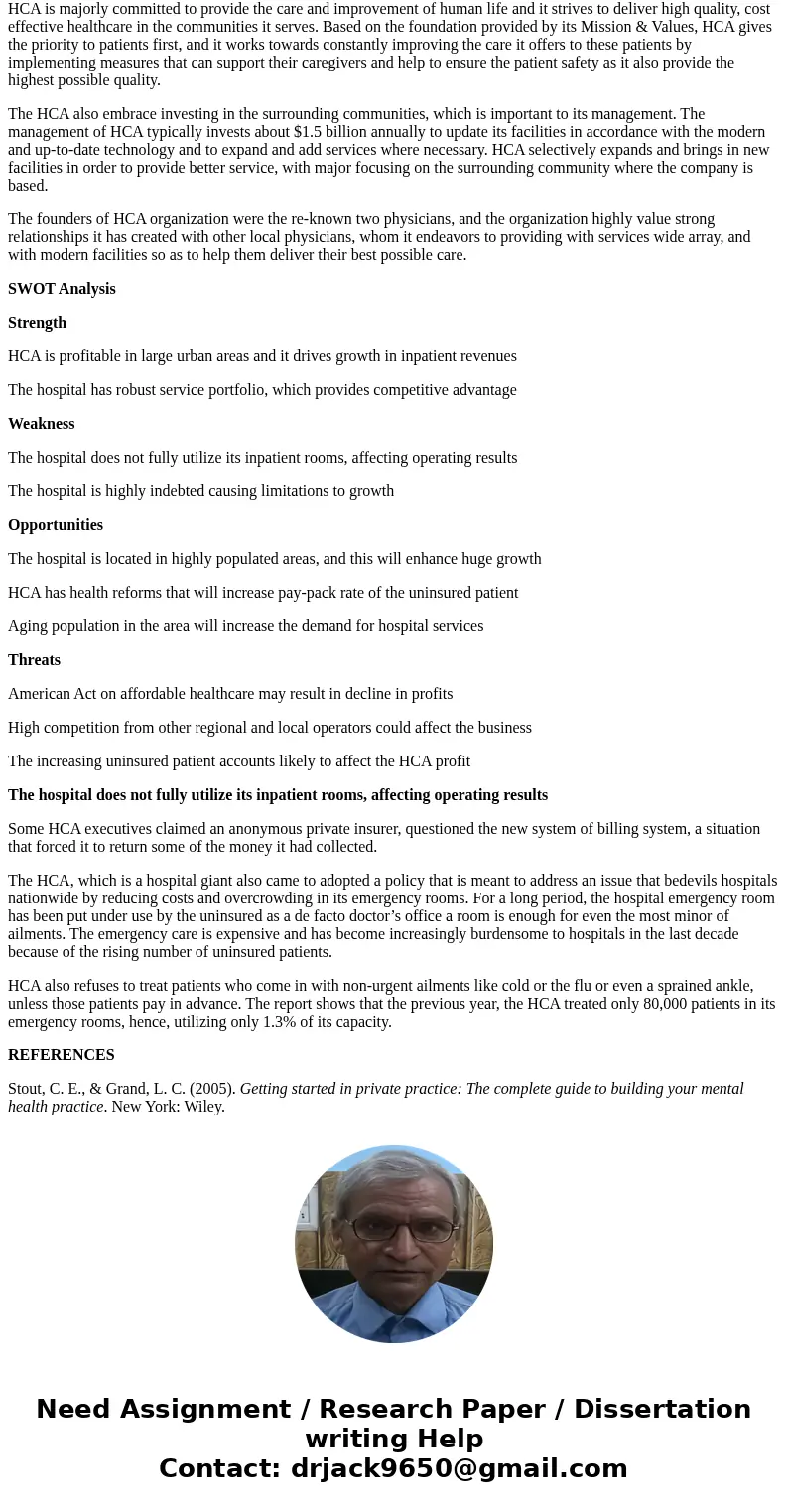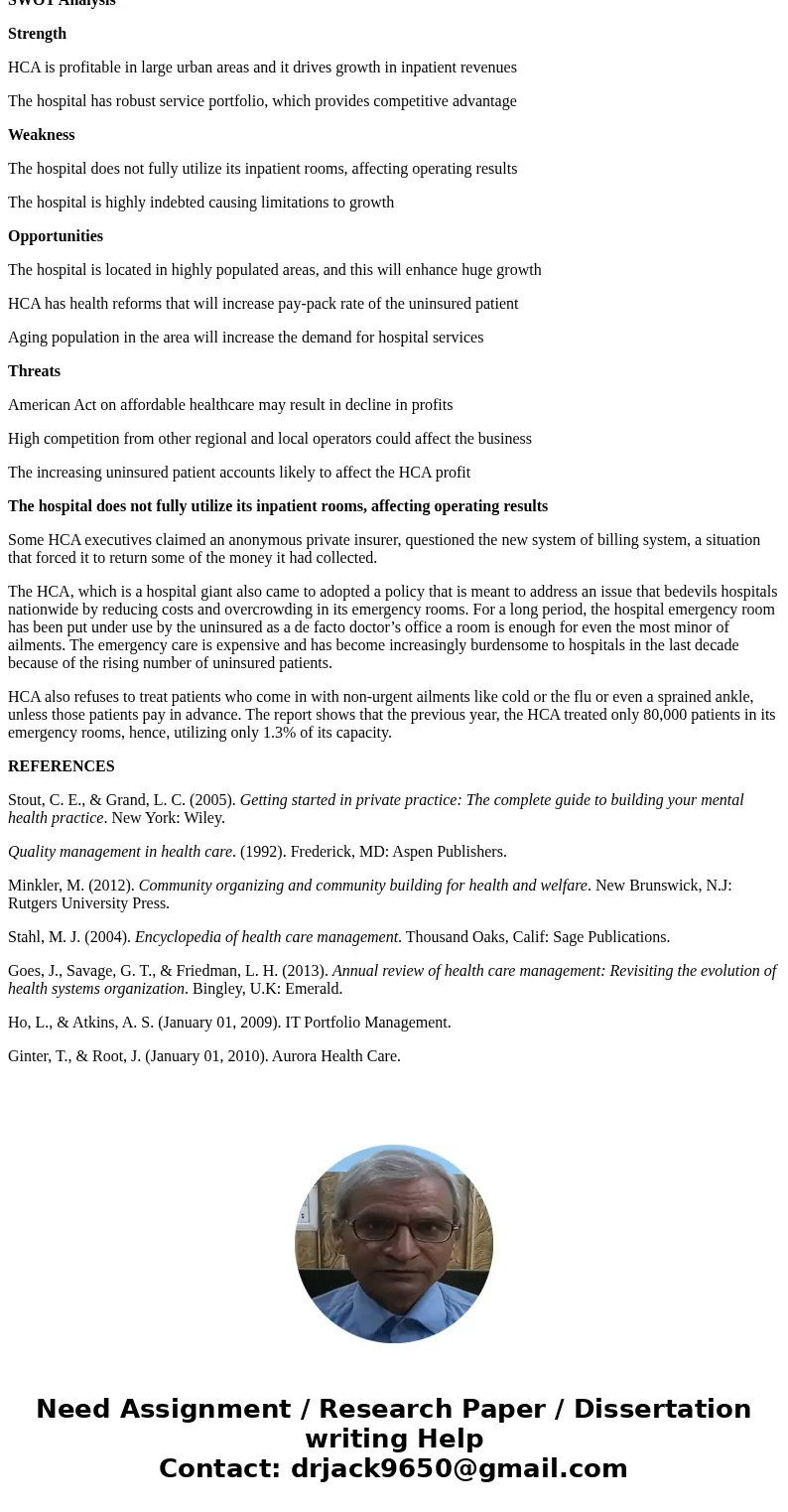The course project requires you to create a quality manageme
The course project requires you to create a quality management plan. To do this, you will:
Identify various aspects of a quality management plan in a healthcare organization.
Apply various processes and tools to enhance quality in a healthcare setting.
Identify workflow processes in a healthcare setting.
Identify quality parameters in a healthcare setting.
Examine the effectiveness of a quality management plan in a given healthcare setting.
The project is modeled on the Shewhart Cycle (Plan, Do, Check, Act). You will modify the Shewhart Cycle to make it applicable to your selected healthcare service or program.
Seek additional resources that will help you understand the process being studied as well as planning and quality improvement in general.
Define: This step describes the importance of the problem within the organization.
Measure: This step relates to the impact of the current condition and target goals for improvement.
Analyze: This step relates to understanding work flow mapping and the value stream as well as understanding root cause analysis (RCA).
Improve: This step identifies improvements to consider in the implementation of change.
Control: This step is about sustainability of change.
Tasks:
Complete a part of the Plan step of the cycle.
Describe the environment, the organization, and the department or program within the organization that is the basis for your project. Describe the selected healthcare setting, specifically its service, staff, equipment, and patients. Identify and describe the scope and nature of the problem.
Assess the environment using strengths, weaknesses, opportunities, and threats (SWOT) analysis. Interview some stakeholders, such as managers, staff, or customers. Use the interview information to conduct the SWOT analysis. You may also summarize or quote any important or interesting information gathered during the interview.
Select one of the weaknesses determined by the SWOT analysis to create a plan for improvement.
Solution
Quality management plan
The Quality Management Plan can be defined as the integral part or the acceptable quality level, that a customer typically defines, and explains how the project will ensure this quality level in its deliverables and processes of work. Quality management plan is important in describing how management of quality is done throughout the projects lifecycle. These include the processes and procedures that ensure good conduction of quality planning, assurance, and control. Like any other organization, healthcare organizations are also required to adjust to maintaining some optimum functionality. As stated in its mission, vision and values, HCA hospital Nashville is dedicated in providing access to coordinated patient-centered care, which supports tomorrow\'s caregivers, and hence translating science into clinical practice.
Nashville-based HCA was founded in 1968 as one of the nations companies and today, it is the leading healthcare services provider.
This company is comprised of facilities managed locally, and they include about 165 hospitals with 115 freestanding surgery centers in 20 states of England and it employs more than 204,000 people. Nashville, Tenn.-based HCA Holdings, under the Chairmanship of Milton Johnson, who is also the Chief Executive Officer, competent leader in exceptional community health care as required in the vision, the health care provides around 5% of the inpatient care in the country.
HCA is majorly committed to provide the care and improvement of human life and it strives to deliver high quality, cost effective healthcare in the communities it serves. Based on the foundation provided by its Mission & Values, HCA gives the priority to patients first, and it works towards constantly improving the care it offers to these patients by implementing measures that can support their caregivers and help to ensure the patient safety as it also provide the highest possible quality.
The HCA also embrace investing in the surrounding communities, which is important to its management. The management of HCA typically invests about $1.5 billion annually to update its facilities in accordance with the modern and up-to-date technology and to expand and add services where necessary. HCA selectively expands and brings in new facilities in order to provide better service, with major focusing on the surrounding community where the company is based.
The founders of HCA organization were the re-known two physicians, and the organization highly value strong relationships it has created with other local physicians, whom it endeavors to providing with services wide array, and with modern facilities so as to help them deliver their best possible care.
SWOT Analysis
Strength
HCA is profitable in large urban areas and it drives growth in inpatient revenues
The hospital has robust service portfolio, which provides competitive advantage
Weakness
The hospital does not fully utilize its inpatient rooms, affecting operating results
The hospital is highly indebted causing limitations to growth
Opportunities
The hospital is located in highly populated areas, and this will enhance huge growth
HCA has health reforms that will increase pay-pack rate of the uninsured patient
Aging population in the area will increase the demand for hospital services
Threats
American Act on affordable healthcare may result in decline in profits
High competition from other regional and local operators could affect the business
The increasing uninsured patient accounts likely to affect the HCA profit
The hospital does not fully utilize its inpatient rooms, affecting operating results
Some HCA executives claimed an anonymous private insurer, questioned the new system of billing system, a situation that forced it to return some of the money it had collected.
The HCA, which is a hospital giant also came to adopted a policy that is meant to address an issue that bedevils hospitals nationwide by reducing costs and overcrowding in its emergency rooms. For a long period, the hospital emergency room has been put under use by the uninsured as a de facto doctor’s office a room is enough for even the most minor of ailments. The emergency care is expensive and has become increasingly burdensome to hospitals in the last decade because of the rising number of uninsured patients.
HCA also refuses to treat patients who come in with non-urgent ailments like cold or the flu or even a sprained ankle, unless those patients pay in advance. The report shows that the previous year, the HCA treated only 80,000 patients in its emergency rooms, hence, utilizing only 1.3% of its capacity.
REFERENCES
Stout, C. E., & Grand, L. C. (2005). Getting started in private practice: The complete guide to building your mental health practice. New York: Wiley.
Quality management in health care. (1992). Frederick, MD: Aspen Publishers.
Minkler, M. (2012). Community organizing and community building for health and welfare. New Brunswick, N.J: Rutgers University Press.
Stahl, M. J. (2004). Encyclopedia of health care management. Thousand Oaks, Calif: Sage Publications.
Goes, J., Savage, G. T., & Friedman, L. H. (2013). Annual review of health care management: Revisiting the evolution of health systems organization. Bingley, U.K: Emerald.
Ho, L., & Atkins, A. S. (January 01, 2009). IT Portfolio Management.
Ginter, T., & Root, J. (January 01, 2010). Aurora Health Care.



 Homework Sourse
Homework Sourse